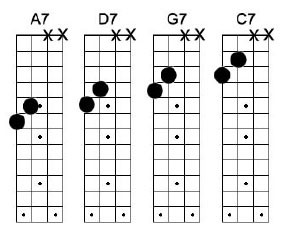« Cafe Interviews |
Main
| 7th Chord Streams »
 October 18, 2012 | V7 Melodic Patterns October 18, 2012 | V7 Melodic Patterns
Enjoy the popular archive material below.
From March 24, 2011: "V7 Melodic Patterns"
We spent some time a few weeks ago looking at combinations and inversions we can adapt to a Dominant 7th (V7) chord. This time out we want to look at melodic opportunities in improvising around the V7 chord. As we mentioned, in 12-bar blues, we have entire songs made up of V7 chords, and knowing how to extract the best notes is crucial in effective soloing.
The most basic choice is to take the chord's major scale, and lower the 7th scale degree. If you're into labels, this is called the Mixolydian mode.
A Major Scale: A B C# D E F# G# A
A Mixolydian: A B C# D E F# G natural A
In our functional hierarchy, the 3rd (Major) and the 7th (Minor) of the group of notes expresses the V7, and anything else supports the defining character. Notes of the scale help, accidentals give variety, but you need the C# and the G natural to convey the essence of the harmony.
In a D7 chord you have:
DMajor Scale: D E F# G A B C# D
D Mixolydian: D E F# G A B C natural D
If you were playing the blues, you'd want to use both scales, and for character, include the minor 3rd and diminished 5th for flavoring, but again it's the 3rd and 7th of each scale that communicates its harmonic nature. Rather than start each note on its root, how about some ergonomic efficiency and smooth voice leading starting the batch on the same notes, in this case the A. On a fretboard, it would look like this in the lower octave:
 
Notice the red notes are not only the only notes that are different in the two patterns, they are also the most important ones in defining the "A7ness" and the "D7ness." There's also a distinct geometric relationship we can pull out, not only in different octaves of the scales, but in different keys. You may recall a progression of 5ths we mapped out in our "Lizard Ear Chords" series at mandolinsessions.com.

You could start the notes on other fingers using the FFcP approach and really open up the possibilities up, down, and across the fretboard, but for now, just work on the A7/D7 combination in the lower octaves, with the 1st FFcP diagrammed above. Try repetitive measures on the A7/D7, and if you want to finish out a 12-bar Blues, all you have to do is add the E7 notes by moving the D7 up two frets.
 
One thing you want to get away from is making your solos sound like you're practicing scales, so try experimenting with both octaves moving up in thirds or fourths. Start in the middle of the scale and go down and back, up and back. Include arpeggios of the A7 and D7 chord. Look to some of the variety in the FFcP exercises to include some melodic variety.
And when you're ready, try other keys, D7/G7, C7/F7, F7/Bb7, Eb7/Ab7. Go nuts!
Further:
Two-chord jam; feed the beast.
Moving Forward; Melodic Progression
Critical Decisions in Improvising: 'Gravity' Notes.
Playing musically: Part 3, play with direction
Blues 501 Jazz!
Posted by Ted at October 18, 2012 7:30 AM

Disclaimer: In the 'Information Age' of the 21st Century,
any fool with a computer, a modem, and an idea can
become a self-professed 'expert." This site does not
come equipped with 'discernment.'
|



